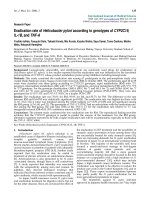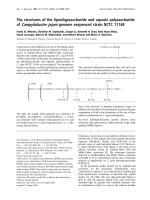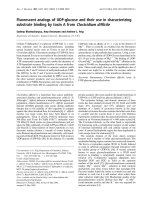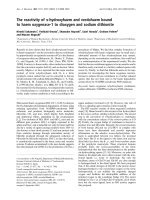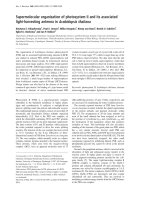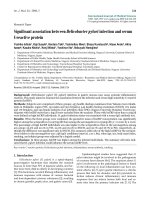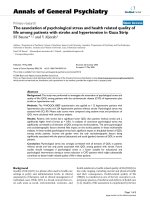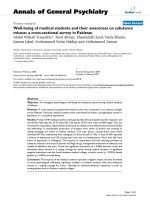Báo cáo y học: " Eradication rate of Helicobacter pylori according to genotypes of CYP2C19, IL-1B, and TNF"
Bạn đang xem bản rút gọn của tài liệu. Xem và tải ngay bản đầy đủ của tài liệu tại đây (215.31 KB, 6 trang )
Int. J. Med. Sci. 2006, 3
135
International Journal of Medical Sciences
ISSN 1449-1907 www.medsci.org 2006 3(4):135-140
©2006 Ivyspring International Publisher. All rights reserved
Research Paper
Eradication rate of Helicobacter pylori according to genotypes of CYP2C19,
IL-1B, and TNF-A
Yoshiko Ishida, Yasuyuki Goto, Takaaki Kondo, Mio Kurata, Kazuko Nishio, Sayo Kawai, Tomo Osafune, Mariko
Naito, Nobuyuki Hamajima
Department of Preventive Medicine / Biostatistics and Medical Decision Making, Nagoya University Graduate School of
Medicine, Nagoya 466-8550, Japan
Correspondence to: Yasuyuki Goto, M.D., Ph.D., Department of Preventive Medicine / Biostatistics and Medical Decision
Making, Nagoya University Graduate School of Medicine, 65 Tsurumai-cho, Showa-ku, Nagoya 466-8550 Japan,
TEL:+81-52-744-2132, FAX:+81-52-744-2971, e-mail:
Received: 2006.08.01; Accepted: 2006.09.10; Published: 2006.09.10
Background: Lansoprazole, amoxicillin, and clarithromycin are commonly used drugs for eradication of
Helicobacter pylori (H. pylori). A few studies reported that the eradication rate was influenced by the functional
polymorphism of CYP2C19, whose product metabolizes proton pomp inhibitors including lansoprazole.
Methods: This study examined the eradication rate among 67 participants in the polymorphism study who
visited Daiko Medical Center, Nagoya University from July 2004 to October 2005. The participants aged 20 to 69
years were classified into three group according to CYP2C19 genotype; rapid metabolizers (RM) with *1*1
genotype, intermediate metabolizers (IM) with *1*2 or *1*3 genotype, and poor metabolizers (PM) with *2*2, *2*3,
or *3*3 genotype. For the genotype classification, G681A (681G for *1 and 681A for *2) and G636A (636G for *1
and 636A for *3) were genotyped by PCR with confronting two-pair primers (PCR-CTPP). They were also
genotyped for IL-1B T-31C and TNF-A T-1031C by a duplex PCR-CTPP.
Results: The eradication rate was 70.0% for RM, 93.9% for IM, and 85.7% for PM. The difference in the rate
between RM and IM+PM was statistically significant (p=0.025). The eradication rate was highest for those with
IL-1B -31CC; the p value was marginal among the whole subjects (χ
2
=3.78, p=0.05) and not significant among
the RM group (χ
2
=1.60, p=0.21). The genotypes of TNF-A T-1031C had no associations with the eradication rate.
But among the RM group, the odd ratio (OR) of the TNF-A CT for the eradication rate relative to TT was
marginally reduced (OR=0.05, 95% confidence interval, 0.002-1.19).
Conclusions: The present study confirmed the low eradication rate for RM. The reproduced finding provides
evidence that the CYP2C19 genotype is useful to predict the success of the treatment. For the RM group,
alternative regimens expected to be with a higher eradication rate will be recommended, especially to those with
the TNF-A -1031C allele.
Key Words: Helicobacter pylori, Eradication, CYP2C19, IL-1B, TNF-A
1. Introduction
Helicobacter pylori (H. pylori) infection is an
established cause of digestive diseases including ulcer,
atrophic gastritis, stomach cancer, and
mucosa-associated lymphoid tissue lymphoma [1-3].
Recent studies demonstrated that H. pylori eradication
caused increase in platelets of patients with idiopathic
thrombocytopenic purpura (ITP) [4,5].
Another study
reported that the eradication may be useful to
treatment of chronic urticaria, an autoimmune disease
[6]. Arteriosclerosis is also presumed to be H. pylori
–associated disease, though there is still controversy
[7]. A study reported that infertility was associated
with the seropositivity among men and women. In
addition, they showed biological evidence that
follicular fluid from infected women contained anti-H.
pylori antibody, which reacted with spermatozoa [8].
In Japan, health insurance covers H. pylori tests
and eradication treatment for digestive ulcers, but not
for the other diseases. Since are convinced the effect of
the eradication on ITP treatment and the possibility of
stomach cancer prevention at least among those who
are successfully treated for early stomach cancer [9],
there are increasing demands for H. pylori eradication
treatment in Japan. In an international workshop held
in Sweden, “the majority of the scientific task force
favored a search-and-treat strategy in first-degree
relatives of gastric cancer patients and an
overwhelming majority felt that a more general
screen-and-treat strategy should be focused in the first
instance on a population with a high incidence of H.
pylori-associated diseases” [10], which may include
Japan, a high stomach cancer incidence country. The
eradication was reported to be effective to reduce the
medical care costs in the United Kingdom [11], and in
Japan [12]. These expert recommendations/opinions
may partly justify the H. pylori eradication for the
more generalized populations in Japan.
The treatments against H. pylori infection
approved in Japanese health insurance are 7-day triple
Int. J. Med. Sci. 2006, 3
136
therapies of lansoprazole (60mg) + amoxicillin
(1,500mg) + clarithromycin (400mg) and omeprazole
(40mg) + amoxicillin (1,500mg) + clarithromycin
(800mg). The reported eradication rate for the former
treatment was 87.5% in 96 patients with gastric ulcer
and 91.1% in 90 patients with duodenal ulcer [13]. The
rate for the latter treatment was reported to be 78.8%
(n=113) by Kuwayama et al at the 7th annual scientific
meeting of the Japanese Society of Helicobacter
Research 2001. Since lansoprazole and omeprazole are
metabolized by CYP2C19 in the liver, the functional
genotypes of CYP2C19 could influence the eradication
rate, as well as clarithromycin resistance of H. pylori.
Concerning the lansoprazole-based triple therapy,
there are two studies reporting the significant
difference in the rate among those with different
CYP2C19 genotypes [14] or with the different
genotype combinations of CYP2C19 and IL-1B [15],
while other studies showed no significant association
[16,17]. It was reported that those with the -511TT
genotype of IL-1B encoding interleukin 1β, a potent
gastric acid inhibiting proinflammatory cytokine, had
a higher eradication rate relative to those with the
-511CC genotype [18].
This study aimed to examine the associations of
the eradication rate with the functional
polymorphisms of CYP2C19 G681A (*2) and G636A
(*3), IL-1B T-31C tightly linked with C-511T [19], and
TNF-A T-1031C. Since TNF-α encoded by TNF-A, is
also a proinflammatory cytokine inhibiting gastric
acid secretion
[20], we
hypothesized
that the
functional
polymorphis
m of TNF-A
may influence
the
eradication
rate. The
TNF-A gene
encoding
TNF- α is
known to
have five
polymorphis
m in the
promoter region; G-238A, G-308A, C-857T, C-863A,
and T-1031C. Among Japanese, the -238A and -308A
alleles are rare and C-863A is tightly linked with
T-1031C. With respect to H. pylori seroposotivity, we
have reported that the decreased OR of TNF-A
-1031CC for H. pylori seropositivity relative to TT was
significant, but the association with C-857T was not
significant [21].
This study was approved by the Ethics
Committee of Nagoya University Graduate School of
Medicine (approval number 155) on June 16, 2004.
2. Subjects and methods
Study subjects
Subjects were sampled from those visited Daiko
Medical Center, Nagoya University, Nagoya, Japan to
seek H. pylori tests and eradication between July 2004
and October 2005. The visitors aged 20 to 69 years
were asked to participate in the polymorphism study.
Those who agreed with a written informed consent
form to provide a 7ml of blood sample and to answer
a questionnaire form on lifestyle including smoking
habit, were enrolled in the present study. Any
genotypes were not disclosed to the participants. The
study protocol was approved by the ethics committee
of the Nagoya University Graduate School of
Medicine.
Treatment for H. pylori infection
Lansoprazole (30mg), amoxicillin (750mg), and
clarithromycin (200mg) twice a day for 7 days (LAC
regimen) were prescribed for those found to be
infected with H. pylori by a
13
C-urea breath test or
serum anti-H. pylori antibody. More than one month
after the medication, a
13
C-urea breath test was
conducted to examine the success/failure of the
eradication treatment.
Figure 1. The agarose gel electrophoresis for polymorphism
at G681A and G636A of CYP2C19 by PCR with
confronting.
Genotyping
DNA was extracted from the buffy coat by a
BioRobot
®
EZ1 (QIAGEN Group, Tokyo) for
genotyping CYP2C19 G681A (*2) and G636A (*3),
IL-1B T-31C, and TNF-A T-1031C. Genotypes were
determined separately for the CYP2C19
polymorphisms by polymerase chain reaction with
confronting two-pair primers (PCR-CTPP) [22]. The
primers for CYP2C19 G681A and G636A were *2F1: 5’
AGA GCT TGG CAT ATT GTA TCT, *2R1: 5’ TAA
GTA ATT TGT TAT GGG TTC CC
, *2F2: 5’ CCA CTA
TCA TTG ATT ATT TCC CA
, *2R2: 5’ TCG ATT CTT
GGT GTT CTT TTA C, and *3F1: 5’ AAC CAG CTA
Int. J. Med. Sci. 2006, 3
137
GGC TGT AAT TGT, *3R1: 5’ CTT GGC CTT ACC
TGG ATC
, *3F2: 5’ ATT GTA AGC ACC CCC TGA,
*3R2: 5’ CAC TGA TCA GGG AGC TAA TG,
respectively. The underlined are the bases of the single
nucleotide polymorphism. Genomic DNA (30ng to
100ng) was used per 25μl of reaction with 0.18mM
dNTPs, 12.5 pmol of each primer, 0.5 units of
"AmpliTaq Gold", and 2.5μl GeneAmp 10×PCR
Buffer including 15mM MgCl
2
(Perkin-Elmer Corp.,
Foster City, CA). Amplification conditions were 10
minutes of initial denaturation at 95°C, followed by 30
cycles of 1 minute at 95°C, 1 minute at 59°C for G681A
and 58°C for G636A, and 1 minute at 72°C, then a 5
minutes final extension at 72°C. The amplified DNA
was visualized on a 2% agarose gel with ethidium
bromide staining. A representative gel is shown in Fig.
1. The alleles were distinguished as follows: a 131-bp
band for the 681G allele and a 105-bp band for 681A
allele, with a 191-bp their common band, and a 377-bp
band for 636G allele and a 255-bp band for 636A allele,
with a 597-bp their common band. IL-1B T-31C and
TNF-A T-1031C were genotyped with a duplex
PCR-CTPP described previously [23].
Statistical analysis
Statistical analysis was performed using STATA
Ver. 8 (College Station, TX) statistical software. The
Hardy-Weinberg equilibrium, which indicates an
absence of
discrepancy between genotype and allele
frequencies, was checked
for the study subjects using a
χ
2
test. The odds ratios (ORs) and 95% confidence
intervals (95% CIs)
were adjusted for sex
(dichotomous) and age (a continuous variable) using
an unconditional logistic regression model.
3. Results
Table 1 describes the backgrounds of the whole
visitors and participants.
From July 2004 to October 2005, 210 persons
visited the center. Among them, 142 were found to be
infected, 165 participated in the polymorphism study
and LAC were prescribed for 93 participants with H.
pylori infection (in fact, 97 were prescribed eradication
drug but 4 subjected who failed the eradication by
LAC at other clinics were excluded because we dosed
them metronidazole instead of clarithromycin). The
distribution of the IL-1B T-31C, CYP2C19 G681A and
G636A genes were in Hardy-Weinberg equilibrium
(χ
2
=0.83 and p=0.36, χ
2
=0.72 and p=0.40, χ
2
=0.54
and p=0.54, respectively), but the distribution of the
TNF-A T-1031C gene was not (χ
2
=4.05, p=0.04). The
difference of the distributions between the expected
and observed from the TNF-A T-1031C gene was not
substantial; 128.3 for 131, 34.4 for 29, and 2.3 for 5. The
participant subjects were classified into three groups
according to CYP2C19 genotype; rapid metabolizers
(RM) with *1*1 genotype, intermediate metabolizers
(IM) with *1*2 or *1*3 genotype, and poor
metabolizers (PM) with *2*2, *2*3, or *3*3 genotype;
*1*1, with the 681GG and 636GG; *1*2, with the 681GA
and 636GG; *1*3 with the 681GG and 636GA; *2*2,
with the 681AA and 636GG; *2*3, with the 681GA and
636GA; *3*3, with the 681GG and 636AA.
Table 1 Characteristics of the visitors and the participants
in the polymorphism study
Characteristics Visitors (n=210)
n (%)
Participants (n=165)
n (%)
Age < 30 years 23 (11.0) 15 (9.1)
31-49 years 52 (24.8) 42 (25.5)
50-69 years 126 (60.0) 106 (64.2)
70 < years 9 (4.3) 2 (1.2)
Sex Males 91 (43.3) 74 (55.2)
Females 119 (56.7) 91 (44.9)
Smoking
a
Never 160 (76.6) 127 (77.0)
Former 25 (12.0) 19 (11.5)
Current 24 (11.5) 19 (11.5)
H. pylori
b
Uninfected 65 (31.6) 55 (33.3)
Infecteted 142 (68.6) 110 (66.8)
CYP2C19 RM - 51 (30.9)
IM - 81 (49.1)
PM - 33 (20.0)
IL-1B C-31T
c
TT - 48 (29.3)
CT - 76 (46.3)
CC - 40 (24.4)
TNF-A C-1031T TT - 131 (79.4)
CT - 29 (17.6)
CC - 5 (3.0)
a
The information on the status of smoking was not available for one
subject.
b
Three subjects among visitors did not take the examination on H.
pylori infection.
c
One subject was not genotyped
Table 2 The rate and odds ratios (ORs) of the eradication
among the participants in the polymorphism study who
were prescribed LAC and examined for the success/failure
of the eradication.
Factors Treated
a
n
Eradicated
n (%)
OR
b
95% CI
Total 67 57 (85.1)
Age
c
< 30 years 1 0 (0.0)
31-49 years 14 10 (71.4)
50-69 years 52 47 (90.4)
70 < years 0 -
Sex Females 33 29 (87.9) 1 (Reference)
Males 34 28 (82.4) 0.69 (0.17-2.82)
CYP2C19 RM 20 14 (70.0) 1 (Reference)
IM 33 31 (93.9) 6.69 (1.12-39.9)
PM 14 12 (85.7) 4.35 (0.55-34.3)
IM+PM 47 43 (91.5) 5.72 (1.24-26.3)
IL-1B -31TT 17 13 (76.5) 1 (Reference)
-31CT 36 30 (83.3) 1.36 (0.31-5.96)
-31CC 14 14 (100) ∞
e
IL-1B
d
-31TT 5 3 (60.0) 1 (Reference)
-31CT 12 8 (66.7) 0.45 (0.03-7.99)
-31CC 3 3 (100) ∞
f
TNF-A -1031TT 51 45 (85.1) 1 (Reference)
-1031CT 14 10 (71.4) 0.33 (0.07-1.51)
-1031CC 2 2 (100) ∞
g
TNF-A
d
-1031TT 16 13 (81.3) 1 (Reference)
-1031CT 4 1 (25.0) 0.05 (0.002-1.19)
-1031CC 0 - -
Smoking Never 49 43 (87.8) 1 (Reference)
Former 12 9 (75.0) 0.49 (0.08-3.00)
Current 6 5 (83.3) 0.82 (0.07-10.0)
Smoking
d
Never 16 12 (75.0) 1 (Reference)
Former 4 2 (50.0) 2.16 (0.12-40.5)
Current 0 - -
a
participants in the polymorphism study who were prescribed LAC and
examined for the success/failure of the eradication.
b
adjusted for sex and
Int. J. Med. Sci. 2006, 3
138
age.
c
p=0.012 for 2 by 3 table using a χ
2
test.
d
Among the participants
with the rapid metabolism.
e,f,g
Compared with reference by a χ
2
test, the p
values were 0.05, 0.21 and 0.61, respectively
Table 2 shows the eradication rate for 67
participants in the polymorphism study who were
prescribed LAC and examined for the success/failure
of the eradication. The combination of CYP2C19 IM
and PM had a significantly high rate relative to RM.
The eradication rate was highest for those with IL-1B
-31CC but the p value was marginal (χ
2
=3.78, p=0.05).
There were no differences in the eradication rate
among those with different genotypes of TNF-A
T-1031C. Among the rapid metabolizers, however, the
decreased OR of TNF-A CT relative to TT was
marginal (OR=0.05, 95% CI, 0.002-1.19). The OR for
current and former smokers at the first visit was 0.82
(95% CI, 0.07-10.0) and 0.49 (95% CI, 0.08-3.00),
respectively. During the medication, two out of six
current smokers quit smoking, three continued
smoking, and one did not answer about smoking
habit.
4. Discussion
In the present study, CYP2C19 IM+PM showed a
significantly high eradication rate relative to RM.
Among the 10 failed, 6 were RM. The IL-1B T-31C
polymorphism was associated with the eradication
rate. Smoking during non-medication period did not
affect the eradication rate. This was the first report on
the possible association between the TNF-A
polymorphism and the eradication rate among those
with RM.
The percentage of RM among those infected with
H. pylori (31.2%) was similar to that of Japanese
populations; by Furuta et al (32.6% of 141 subjects) [14],
by Take et al (32.5% of 249 subjects) [15], by Kawabata
et al (41.3% of 80 subjects) [16],
and by Sugimoto et al
(38.1% of 315 controls infected with H. pylori) [24].
Those percentages are much lower than those in
Europe (81.1% of 143 subjects in Italy [25] and 73.3%
of 60 subjects in Germany [26]). The allele frequencies
for IL-1B -31T (0.536) and TNF-A -1031T (0.871) in this
study were also similar to those among Japanese
(0.558 of 1,062 chromosomes [27], and 0.835 of 2,742
chromosomes [21], respectively), and lower and
higher than that in Italy (0.669 and 0.768 of 1,288
chromosomes, respectively) [28].
To date, four studies examined the association of
the eradication rate with the CYP2C19 genotypes. Two
studies demonstrated non-significant results contrary
to ours; in a randomized controlled study of
lansoprazole versus rabeprazole for 187 patients with
digestive ulcer by Kawabata et al [16], the eradication
rate was 73% for 33 RM, 74% for 35 IM, and 83% for 12
PM in the LAC group, and in the study by Miki et al
[17], 83% for 12 RM, 85% for 26 IM, and 78% for 9 PM.
Although the corresponding association is
controversial, our present study confirmed that the
RM group relatively resistant to LAC should be
treated with a more effective alternative regimen.
Accordingly, the genotyping of CYP2C19 before
eradication treatment could be useful to avoid the
failure of treatment.
The present study indicated that the
polymorphism of IL-1B T-31C tightly linked with
C-511T is one of the determinants on the result of H.
pylori eradication. Among the RM group, IL-1B -31CC
tended to show the highest eradication rate but the p
value was not significant (χ
2
=1.60, p=0.21). Although
the association with combinations of CYP2C19 and
IL-1B C-511T was reported [15], our data did not reach
significance, probably due to the small number of
subjects analyzed.
TNF-A T-1031C did not provide useful
information to predict the result of the eradication
treatment. But among the RM group, TNF-A T-1031C
was useful as the indication of the success/failure of
the eradication. TNF-A C-863A polymorphism linked
tightly to T-1031C affects TNF-α expression; -863 A
was associated with a lower serum TNF-α level.
29
Previously we have reported that TNF-A -1031TT was
associated with persistent H. pylori infection and
hypothesized that TNF-A -1031TT produces the high
level of TNF-α, resulting in low gastric acid [21]. This
study also indicated that those with the RM and
TNF-A -1031CT genotype could not suppress gastric
acid enough to eradicate H. pylori. Because this result
was based on the small numbers, studies of a larger
size are needed to confirm our finding.
The problem of clarithromycin-resistant H. pylori
is substantial in the eradication, but we could not
determine the drug resistance because endoscopy was
not conducted in our clinic. This is one of the
limitations of this study. It was reported that the
eradication rate was quite low among the RM group
infected with clarithromycin-resistant H. pylori [14].
Take et al reported that in a mulitivariate analysis,
susceptibility to clarithromycin and CYP2C19 were
significant factors, with IL-1B C-511T and smoking not
significant, but the association of CYP2C19 genotype
was marked only among those with IL-1B -511CC [15].
The relation between the TNF-A genotype and the
eradication rate according to the status of H. pylori
drug resistance remains to be elucidated.
It has been well documented that smokers had a
lower success probability of the eradication [30-32].
On
the other hand, smokers who quit smoking during the
medication reportedly had a higher eradication rate
[32]. We strongly recommended to quit smoking
during the medication, so two quit smoking at least
during the medication and succeeded in H. pylori
eradication. Since the smokers during the medication
were four at most, eradication rate for smokers could
not be estimated with an enough statistical power.
In conclusion, the present study confirmed the
low eradication rate among the RM who were treated
with LAC. The reproduced finding provides evidence
that the CYP2C19 and IL-1B genotype are useful to
predict the success of the treatment. For the RM group,
alternative regimens expected to be with a higher
eradication rate will be recommended especially to
those with the TNF-A -1031C allele. Further biological
Int. J. Med. Sci. 2006, 3
139
investigation will be required to elucidate the
association of these polymorphisms and the
eradication rate. Based on the finding, we began in
November 2005 to inform the participants of the
CYP2C19 genotype to recommend another triple
therapy (rabeprazole, metronidazole, and amoxicillin)
for those with RM [16,33].
Acknowledgments
The authors are grateful to Ms. Yoko Mitsuda
and Ms. Mayumi Kato for their technical assistance.
This work was supported in part by a Grant-in-Aid for
Cancer Research (17Shitei-6) from the Ministry of
Health, Labour and Welfare of Japan.
Conflicts of interest
The authors have declared that no conflict of
interest exists.
References
1. Labenz J, Borsch G. Evidence for the essential role of
Helicobacter pylori in gastric ulcer disease. Gut. 1994; 35: 19-22.
2. IARC. Infection with Helicobacter pylori. In: IARC monographs
on the evaluation of the carcinogenic risks to humans. Lyon,
France: International Agency for Research on Cancer. 1994:
177-241.
3. Wundisch T, Thiede C, Morgner A, et al. Long-term follow-up
of gastric MALT lymphoma after Helicobacter pylori eradication.
J Clin Oncol. 2005; 23: 8018-24.
4. Kohda K, Kuga T, Kogowa K, et al. Effective of Helicobacter
pylori eradication on platelet recovery in Japanese patients with
chronic idiopathic thrombocytopenic purpura and secondary
autoimmune thrombocytopenic purpura. Br J Haematol. 2002;
118: 584-8.
5. Suzuki T, Matsushima M, Masui A, et al. Effect of Helicobacter
pylori eradication in patients with chronic idiopathic
thrombocytopenic purpura – a randomized controlled trial.
Am J Gastroenterol. 2002; 100: 1271-3.
6. Fukuda S, Shimoyama T, Umegaki N, et al. Effect of
Helicobacter pylori eradication in the treatment of Japanese
patients with chronic idiopathic urticaria. J Gastroenterol. 2004;
29: 827-30.
7. Franceschi F, Leo D, Fini L, et al. Helicobacter pylori infection
and ischaemic heart disease: an overview of the general
literature. Dig Liver Dis. 2005; 37: 301-8.
8. Figura N, Piomboni P, Ponzetto A, et al. Helicobacter pylori
infection and infertility. Eur J Gastroenterol Hepatol. 2002; 14:
663-9.
9. Uemura N, Mukai T, Okamoto S, et al. Effect of Helicobacter
pylori eradication on subsequent development of cancer after
endoscopic resection of early gastric cancer. Cancer Epidemiol
Biomarkers Prev. 1997; 6: 639-42.
10. Malfertheiner P, Sipponen P, Naumann M, et al. H.
pylori-Gastric Cancer Task Force. Helicobacter pylori eradication
has the potential to prevent gastric cancer: a state-of-the-art
critique. Am J Gastroenterol. 2005; 100: 2100-115.
11. Ford A.C, Forman D, Bailey A.G, et al. A community screening
program for Helicobacter pylori saves money: 10-year follow-up
of a randomized controlled trial. Gastroenterology. 2005; 129:
1910-7.
12. Sone Y, Kumada T, Kiriyama S, et al. Helicobacter pylori
eradication reduces medical care costs: a community-based
study. Helicobacter Res. 2002; 6: 299-304.
13. Asaka M, Sugiyama T, Kato M, et al. A multicenter,
double-blind study on triple therapy with lansoprazole,
amoxicillin and clarithromycin for eradication of Helicobacter
pylori in Japanese peptic ulcer patients. Helicobacter. 2001; 6:
254-61.
14. Furuta T, Sagehashi Y, Shirai N, et al. Influence of CYP2C19
polymorphism and Helicobacter pylori genotype determined
from gastric tissue samples on response to triple therapy for H
pylori infection. Clin Gastroenterol Hepatol. 2005; 3: 564-73.
15. Take S, Mizuno M, Ishiki K, et al. Interleukin-1β genetic
polymorphism influences the effect of cytochrome P 2C19
genotype on the cure rate of 1-week triple therapy for
Helicobacter pylori infection. Am J Gastroenterol. 2003; 98:
2403-8.
16. Kawabata H, Habu Y, Tomioka H, et al. Effect of different
proton pump inhibitors, differences in CYP2C19 genotype and
antibiotic resistance on the eradication rate of Helicobacter pylori
infection by a 1-week regimen of proton pump inhibitor,
amoxicillin and clarithromycin. Aliment Pharmacol Ther. 2003;
17: 259-65.
17. Miki I, Aoyama N, Sakai T, et al. Impact of clarithromycin
resistence and CYP2C19 genetic polymorphism on treatment
efficacy of Helicobacter pylori infection with lansoprazole- or
rabeprazole-based triple therapy in Japan. Eur J Gastroenterol
Hepatol. 2003; 15: 27-33.
18. Furuta T, Shirai N, Xiao F, et al. Polymorphism of
interleukin-1B affects the eradication rates of Helicobacter pylori
by triple therapy. Clin Gastroenterol Hepatol. 2004; 2: 22-30.
19. Hamajima N, Matsuo K, Saito T, et al. Interleukin 1
polymorphisms, lifestyle factors, and Helicobacter pylori
infection. Jpn J Cancer Res. 2001; 92: 383-9.
20. Beales I.L, Calam J. Interleukin 1 beta and tumour necrosis
factor alpha inhibit acid secretion in cultured rabbit parietal
cells by multiple pathways. Gut. 1998; 42: 227-34.
21. Hamajima N, Shibata A, Katsuda N, et al. Subjects with
TNF-A-857TT and -1031TT genotypes showed the highest
Helicobacter pylori seropositive rate compared with those with
other genotypes. Gastric Cancer. 2003; 6: 230-6.
22. Hamajima N, Saito T, Matsuo K, et al. Polymerase chain
reaction with confronting two-pair primers for polymorphism
genotyping. Jpn J Cancer Res. 2000; 91: 865-8.
23. Atsuta Y, Kawase H, Hamajima N, et al. Use of duplex
PCR-CTPP methods for CYP2E1 RsaI/IL-2 T-330G and IL-1B
C-31T/TNF-A T-1031C polymorphisms. Mol Diagn. 2005; 9:
89-94.
24. Sugimoto M, Furuta T, Shirai N, et al.. Poor metabolizer
genotype status of
CYP2C19 is a risk factor for developing
gastric cancer in Japanese patients with Helicobacter pylori
infection. Aliment Pharmacol Ther. 2005; 22: 1033-40.
25. Sapone A, Vaira D, Trespidi S, et al. The clinical role of
cytochrome P450 genotypes in Helicobacter pylori management.
Am J Gastroenterol. 2003; 98: 1010-15.
26. Timm R, Kaiser R, Lotsch J, et al. Association of
cyclophosphamide pharmacokinetics to polymorphic
cytochrome P450 2C19. Pharmacogenomics J. 2005; 5: 365-73.
27. Hamajima N, Ito H, Matsuo K, et al. Helicobacter pylori
seropositivity, the interleukin 1B polymorphism, and smoking
among first-visit outpatients. Asian Pac J Cancer Prev. 2002; 3:
23-8.
28. Zambon CF, Basso D, Navaglia F, et al. Pro- and
anti-inflammatory cytokines gene polymorphisms and
Helicobacter pylori infection: interactions influence outcome.
Cytokine. 2005; 29: 141-52.
29. Skoog T, van't Hooft FM, Kallin B, et al. A common functional
polymorphism (C-->A substitution at position -863) in the
promoter region of the tumour necrosis factor-alpha
(TNF-alpha) gene associated with reduced circulating levels of
TNF-alpha. Hum Mol Genet. 1999; 8: 1443-9.
30. Kamada T, Haruma K, Komoto K, et al. Effect of smoking and
histological gastritis severity on the rate of H. pylori eradication

